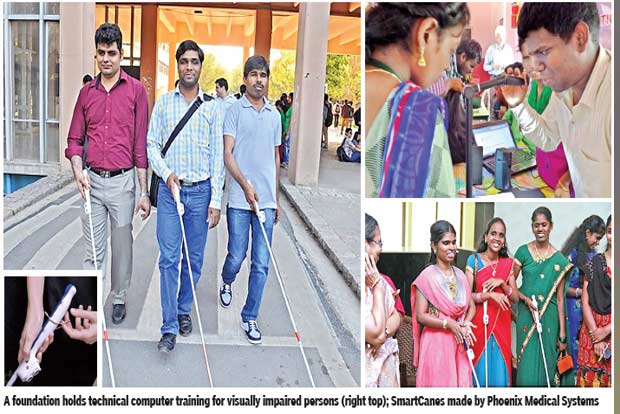Begin typing your search...
Assistive technology for differently abled still in nascent stage
While affordability is the main reason, long-winded and laborious application process make financial assistance schemes run by State and Centre out of reach.

Chennai
From wheelchairs to visual aids, assistive technology aid differently-abled people in their day-to-day functioning and offers independence in their lives. Yet, in Chennai, assistive aids are still not accessible for those who need it the most.
The World Health Organisation (WHO) defines assistive technology as any tool that “maintain or improve an individual’s functioning and independence to facilitate participation and to enhance overall well-being.” According to their estimate, only 5 to 15 per cent of people who need these technologies have access to them in low- and middle-income nations.
According to K Raghuraman, secretary of the Karna Vidya Foundation which provides technological training for the visually impaired, Chennai is still in the nascent stages of assistive technology penetration.
This low accessibility is due to financial factors, he said. “For those from lower-income brackets, which amounts to a large number of people, assistive technology is too expensive. For example, an audio-portable player, which helps us access educative and entertainment media, costs nearly Rs 17,000. This is simply not feasible for many families,” he said.
While differently-abled people can access programmes from State and Central Governments to avail financial relief, the low number, low frequency and winding and laborious application process for the schemes push people away, he said.
This lack of demand also affects suppliers of assistive technology. Phoenix Medical Systems, upon the recommendation of the researchers from IIT-Delhi who developed the SmartCane, attempts to provide the tool at an affordable cost for consumers. “We were approached by researchers from IIT, Delhi, after they had been rejected by other companies, as they wanted to sell the product at an affordable rate of Rs 3,000. If we priced the cane at Rs 3,000, manufacturing costs would mean that we would not be able to earn any profit,” said Subhashree Rajan, manager marketing, Phoenix Medical Systems. By keeping their prices affordable, however, the company was able to slowly move units into the market, selling nearly one lakh units to date. However, Rajan felt that subsidies must be provided for private companies producing these products to motivate and encourage sales.
As Chennai remains a new market for this technology, many products offered across the globe are not available in the nation easily, said D Ravi, managing director of CMD Precision Products Pvt Ltd, which produces white canes for people with visual impairment. “Awareness needs to be brought in the market. Even the wheelchair has many variants that ensure that people with disability can lead their lives independently. Despite the large population of people with disability, India still offers too few options for them,” he said.
Yet, this lack of accessibility does not end once the product is in the user’s hands. Raghuraman explained that proper training must be conducted by parents and NGOs to ensure that the product is used effectively. Orientation, follow-up sessions and giving training for parents are key to ensure these products benefit the lives for those they were designed for.
“Many people are hesitant to use assistive technology due to lack of training. If provided with proper training, a person with a disability can use these products in such a manner that they are getting the most out of it. This is where many fail and so much technology goes to waste,” said Raghuraman.
In the WHO publication titled Community Based Rehabilitation: CBR Guidelines that was published in 2010, a case study from Andhra Pradesh read, “…provided sandals made of black microcellular rubber to people with leprosy who had lost sensation in their feet and were at risk of foot ulcers. It became obvious that many people who were provided with these sandals did not use them. After talking with these people, it was discovered that by wearing the sandals they were subject to social stigma – the black sandals had become easily identifiable in the community as shoes that only people with leprosy wore.” The findings from this report drive home Raghuraman’s insistence for a healthy ecosystem for assistive technology. “When in an encouraging and motivating environment that facilitates the use of assistive technology, people with disability will be able to use these devices to help them in education, employment and for a better quality of life,” he said.
Wheelchairs are some of the more visible and widespread assistive technology in India. Priced anywhere from Rs 39,000 to Rs 1.5 lakh, they come in both electric and manual models. Canes for people with visual impairment cost anywhere from Rs 300 to Rs 3,500. Tactile books for visually impaired children are in high demand, as they help with early literacy, comprehension and tactile perception. However, very few of these books are available in the city. They cost anywhere between Rs 800 to Rs 3,000.
Visit news.dtnext.in to explore our interactive epaper!
Download the DT Next app for more exciting features!
Click here for iOS
Click here for Android
Next Story



